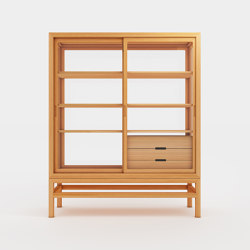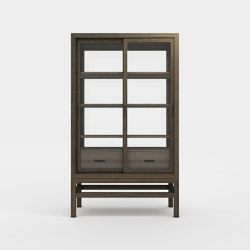Museum cabinet for private collection
Display cabinets from Time & Style
Product description
W1400×D450×H1700
Concept
Thinking of cabinets that complement displayed collections in the most beautiful way, like display cases in museums, this glass cabinet is named “museum cabinet for private collection”. Natural light through the glass reaches all corners of the cabinet, making the stored goods — such as dinnerware, glasses, keepsakes, and long-standing collections — look natural. We desired to create a cabinet that complements stored collections, while having durability and functionality that allows for mass storage of stacked heavy dinnerware or large art/photograph collection books (the cabinet can be used as a heavy-duty bookshelf).
Directing outside light from multiple directions to the inside, while having the strength to bare heavy weights: our challenge was to direct enough light even to the lowest shelf, and to preserve the natural appearance of the stored items. Although the top parts of regular bookshelves and cabinets appear well-lit, the light becomes dimmer on the lower shelves, and the goods stored on the lowest shelf cannot be seen. Cabinets with artificial lights, such as LED tape lights or halogen spot lights, do not necessarily complement the stored collections. Our additional rule was to avoid interior lights, and metals including hinges, completing the cabinet only with woodworking techniques. Light can go through all windows except the bottom. With light from five windows (the top, front, back, and sides), the stored items are uniformly illuminated.
The Japanese sliding style is used for the two doors with glass inserts. The traditional analog style uses carved grooves on the top and bottom parts of the door frame to attach the sliding doors, rather than using metal parts, such as slide rails and rail guides. Traditional Japanese furniture and house fixtures were referenced for the horizontal movement of the double sliding door. Only two domestic types of timber, native oak and mountain cherry from Hokkaido, were used as the materials. We thought that North American walnut lumber does not match with the oriental design of the cabinet. Many timbers of these two types have small diameters since they are grown in Japan, and are not suitable for products with large surfaces (e.g., table tops) due to multiple joints. However, this cabinet uses a 45mm square frame as the base material for the product, and does not require wide-width materials. Nevertheless, it was difficult to make a frame from one square piece of domestic timber. In order to connect 45mm square timbers, process it, and finish it as a product, 50mm square material was required.
For making this cabinet, we focused on careful selection of materials, processing (joints in the product, wooden framework methods, chamfering, and surface shape of lumber), and finishing method (painting and staining). The outside wooden framework was made with the “mengoshi-hagi (mitered sticking)” joint. The square lumber for the frame was chamfered to have soft r-shaped edges, and a piece called “oshibuchi (batten)” is used to insert the glass. In order to obtain strength for the legs and reinforce the cabinet body, the joints of the legs and rungs employed “ryomengoshi-hagi”, resulting in unity of strength and design. The outside of the frame is curved, instead of flat, and this added a soft impression to the entire wood of the square-shaped cabinet with a hard expression. A classic round-shaped design, called “tamabuchi”, was used for the inside of the square lumber of the outside frame. Furthermore, the sliding doors were chamfered in a classical way (“gin-nan men”), in pursuit of a Japanese and oriental overall design.
The museum cabinet for private collection was designed and made based on a broad “oriental” (not only Japanese) concept. Japan’s neighboring countries (e.g., China, Korea, and others) share at their core the concept of “orient”; a concept that governs the origin of Japanese culture. We believe that for our future creations, it is very important to know the connection with and history of neighboring countries, where Japanese culture originated from, by searching for the origin of our historic background, including philosophies, histories, technologies, and designs. Western cultures are adored in modern Japan. In particular, today’s manufacturing is based on the Western way of thinking and evaluation standards. In order to modernize designs and manufacturing, many industries value mechanization, industrialization, and streamlining. They shifted directions of manufacturing by westernization and mechanization, in order to achieve mass production. In the field of design, Western concepts, rather than unique Japanese designs, are still the standard in Japan for basic designs. However, we have a common aesthetic concept among countries like Japan, China, Korea, and others. Manufacturing based on the oriental values has been conducted through communication for over 2,000 years. We believe that it is necessary to quit solely chasing after Western designs and manufacturing concepts. In other words, we believe it is time for us to examine the values and concepts of unique Japanese and oriental manufacturing, and to reconstruct unique values transmitted from the East, or Japan.
With one such oriental concept of ours, the “museum cabinet for private collection” was made. The product envelopes Chinese and Korean histories, cultures, and connections with Japan. This idea was embodied as the integrated elements in this entire product design, proposing comprehensive “oriental beauty”. The museum cabinet for private collection was designed utilizing details seen in Ming Dynasty woodwork, while also integrating the Joseon Dynasty style as a design style. We also tried to maintain a balance between the individual elements of unique Japanese functionality and design. Our journey of creation with a theme “oriental beauty” had just begun.
Directing outside light from multiple directions to the inside, while having the strength to bare heavy weights: our challenge was to direct enough light even to the lowest shelf, and to preserve the natural appearance of the stored items. Although the top parts of regular bookshelves and cabinets appear well-lit, the light becomes dimmer on the lower shelves, and the goods stored on the lowest shelf cannot be seen. Cabinets with artificial lights, such as LED tape lights or halogen spot lights, do not necessarily complement the stored collections. Our additional rule was to avoid interior lights, and metals including hinges, completing the cabinet only with woodworking techniques. Light can go through all windows except the bottom. With light from five windows (the top, front, back, and sides), the stored items are uniformly illuminated.
The Japanese sliding style is used for the two doors with glass inserts. The traditional analog style uses carved grooves on the top and bottom parts of the door frame to attach the sliding doors, rather than using metal parts, such as slide rails and rail guides. Traditional Japanese furniture and house fixtures were referenced for the horizontal movement of the double sliding door. Only two domestic types of timber, native oak and mountain cherry from Hokkaido, were used as the materials. We thought that North American walnut lumber does not match with the oriental design of the cabinet. Many timbers of these two types have small diameters since they are grown in Japan, and are not suitable for products with large surfaces (e.g., table tops) due to multiple joints. However, this cabinet uses a 45mm square frame as the base material for the product, and does not require wide-width materials. Nevertheless, it was difficult to make a frame from one square piece of domestic timber. In order to connect 45mm square timbers, process it, and finish it as a product, 50mm square material was required.
For making this cabinet, we focused on careful selection of materials, processing (joints in the product, wooden framework methods, chamfering, and surface shape of lumber), and finishing method (painting and staining). The outside wooden framework was made with the “mengoshi-hagi (mitered sticking)” joint. The square lumber for the frame was chamfered to have soft r-shaped edges, and a piece called “oshibuchi (batten)” is used to insert the glass. In order to obtain strength for the legs and reinforce the cabinet body, the joints of the legs and rungs employed “ryomengoshi-hagi”, resulting in unity of strength and design. The outside of the frame is curved, instead of flat, and this added a soft impression to the entire wood of the square-shaped cabinet with a hard expression. A classic round-shaped design, called “tamabuchi”, was used for the inside of the square lumber of the outside frame. Furthermore, the sliding doors were chamfered in a classical way (“gin-nan men”), in pursuit of a Japanese and oriental overall design.
The museum cabinet for private collection was designed and made based on a broad “oriental” (not only Japanese) concept. Japan’s neighboring countries (e.g., China, Korea, and others) share at their core the concept of “orient”; a concept that governs the origin of Japanese culture. We believe that for our future creations, it is very important to know the connection with and history of neighboring countries, where Japanese culture originated from, by searching for the origin of our historic background, including philosophies, histories, technologies, and designs. Western cultures are adored in modern Japan. In particular, today’s manufacturing is based on the Western way of thinking and evaluation standards. In order to modernize designs and manufacturing, many industries value mechanization, industrialization, and streamlining. They shifted directions of manufacturing by westernization and mechanization, in order to achieve mass production. In the field of design, Western concepts, rather than unique Japanese designs, are still the standard in Japan for basic designs. However, we have a common aesthetic concept among countries like Japan, China, Korea, and others. Manufacturing based on the oriental values has been conducted through communication for over 2,000 years. We believe that it is necessary to quit solely chasing after Western designs and manufacturing concepts. In other words, we believe it is time for us to examine the values and concepts of unique Japanese and oriental manufacturing, and to reconstruct unique values transmitted from the East, or Japan.
With one such oriental concept of ours, the “museum cabinet for private collection” was made. The product envelopes Chinese and Korean histories, cultures, and connections with Japan. This idea was embodied as the integrated elements in this entire product design, proposing comprehensive “oriental beauty”. The museum cabinet for private collection was designed utilizing details seen in Ming Dynasty woodwork, while also integrating the Joseon Dynasty style as a design style. We also tried to maintain a balance between the individual elements of unique Japanese functionality and design. Our journey of creation with a theme “oriental beauty” had just begun.
More about this product
Part of the collection
CABINET / SHELF.
Manufacturer
Time & Style
Family
Museum cabinet for private collection
Architonic ID
20129293
Order number
C-504
Year of Launch
2015
More products from Museum cabinet for private collection family
Downloads
Manufacturer’s Catalogues
Related Projects
Contact information
Address
4-27-15.Minamiaoyama.Minato-ku, 107-062 Tokyo Japan
Get more information
Sign in to your Architonic account to have your contact details filled out automatically for each request.
Where to buy this product

More from
Time & StyleContact information
Address
4-27-15.Minamiaoyama.Minato-ku, 107-062 Tokyo Japan
Where to buy this product



